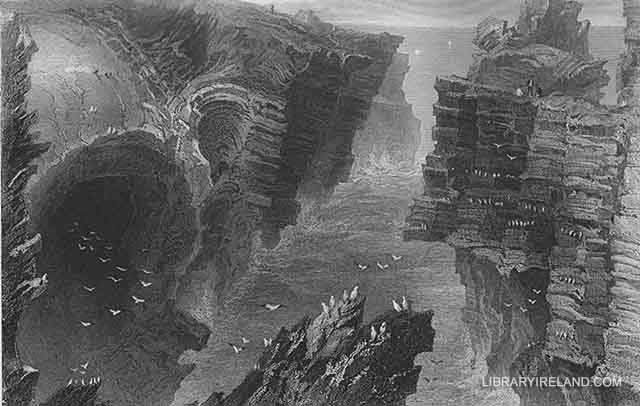The Puffing Rock near Kilkee, County Clare
The following is Mrs. Knott's account of the Puffing Rock near Kilkee. It is about fifty feet high and thirty feet square, and has an opening down through the middle to a large chamber beneath; and when the breakers are driven in by strong wind and tide, after filling the lower space, the water is spouted up through the aperture like graceful feathery plumes, and descending in mist, produces, when the sun shines brightly, a most vivid and beautiful iris, whose arch may be seen by standing with your back to the sun. The whole of the coast near the mouth of the Shannon is rather extraordinary, and by crossing the river we come to the CAVES OF BALLYBUNNIAN on the Kerry side.
"This bay," says a traveller who visited the caves in 1833, "is about five hundred paces in width, and its sands, which are piled up the sides of its inner portion, are dry and firm, though the prevalence of westerly winds and the strength of its currents mar the pleasantness and security of the bathing. The cliffs, which front the northern side, extend about two hundred and ninety yards, and rise gradually from the east to the west, or towards the sea, where they attain a height of one hundred and ten feet. They preserve throughout great perpendicularity, and are composed of two great beds, from thirty to forty feet in thickness, of compact ampelite, divided by a seam of the same slate, but fissile and anthracitous, and pouring out streamlets of water which contain iron and salts in solution, and tinge the rocks with bright yellow ochreous colours. These cliffs are also penetrated by several caves of small dimensions, which open upon the bay, and are crossed in one place by a fissure, occasioned by the fracturing of a rock which dips at a small angle of inclination (four to five degrees) to the east. The last cave on the sea-side, which has also an entrance from the bay, immediately curves round, and allows the sea to be seen, breasting its foaming way with much impetuosity, even on calm days, up two distinct apertures, through which the light gleams with almost starlight brightness.
"Any attempt to describe the connection and relation of all these minor caves would be obviously a tedious enumeration, not warranted by their importance. They are most easily navigated in a boat from the northern side, where the rocky passages may be traversed for a considerable distance, without any communication with the open sea: and during this navigation, which is chiefly carried on in a line parallel to the western face of the cliff, the various entrances are often crossed at right angles, affording the most striking contrast of light and shade—the colour of the waters being often of a hue so sparklingly bright, and so extensively vivid, as to resemble molten silver; while the boat hurries through the deep and wave-worn arcades into light and airy arched or vaulted chambers, only in their innermost recesses dark and repulsive, and passes from cave to cave, and hall to hall, with inlets, pointing to the sea, or high cliffs affording their protection against the waves, and occasionally well-like apertures, which open through the roof to yield a telescopic view of the heavens, assisting, more especially with the sudden transitions from absolute darkness to the most brilliant light, in giving to the whole an appearance of fairy scenery."
W. Ainsworth having entered from the Kerry shore, does not allude to the entrance from the Clare side; and as we know that much disappointment occurred to a party from Kilkee, who went by the way of Carrigaholt, and attempting to get back the same way, were carried by the tide up to Kilrush, and did not reach home until next morning, we are enabled to give the following hints, as they were communicated to a friend of ours by James Patterson of Kilrush, from whose well-known nautical knowledge and experience the information may be useful to other visitors, and prevent danger and disappointment. This gentleman, it appears, was one of the first who explored the dark and extensive recesses of the great caves, into which he took with him blue-lights and torches. He says that it requires the wind to blow for two days off the land, say easterly or south-east, in order that the sea may be sufficiently calm; should it be at all from the west, the water is so rough that a boat could not enter. When the weather is favourable, he advises to take a boat at Kilrush, and go down with the first ebb of the tide, which may not be half out when the caves are reached, at ten miles' distance; three or four hours can then be spent in examining them; and on the boat coming out, the flowing tide rushing in brings them back to Kilrush with ease. Parties should also get the opinion of some person well acquainted with the place as to providing suitable boats; for large ones can get into but few of the caves, the entrances being low and narrow, and very small boats are unsafe to cross the river.

